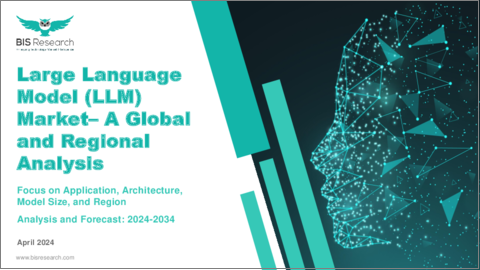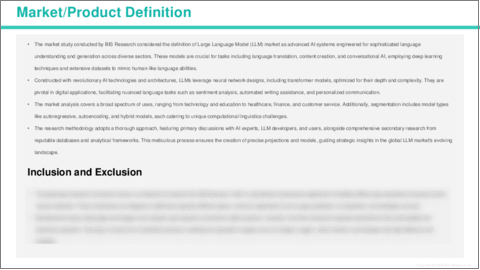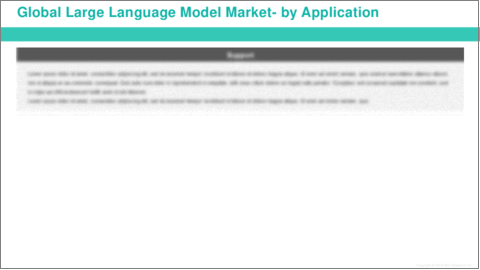|
|
市場調査レポート
商品コード
1472972
大規模言語モデル(LLM)の世界市場- 世界および地域別分析:用途別、アーキテクチャ別、モデルサイズ別、地域別-分析と予測(2024年~2034年)Large Language Model (LLM) Market - A Global and Regional Analysis: Focus on Application, Architecture, Model Size, and Region - Analysis and Forecast, 2024-2034 |
||||||
カスタマイズ可能
|
|||||||
| 大規模言語モデル(LLM)の世界市場- 世界および地域別分析:用途別、アーキテクチャ別、モデルサイズ別、地域別-分析と予測(2024年~2034年) |
|
出版日: 2024年05月02日
発行: BIS Research
ページ情報: 英文 100 Pages
納期: 1~5営業日
|
- 全表示
- 概要
- 目次
世界の大規模言語モデル(LLM)の市場規模は、様々な重要な要因や力学に後押しされ、著しい急成長を遂げています。
楽観的シナリオを考慮すると、2024年の市場規模は64億米ドルになるとみられ、今後は29.61%のCAGRで拡大し、2034年には856億米ドルに達すると予測されています。この成長の中心となっているのは、さまざまな分野で強化された自然言語処理能力に対する需要の高まりです。LLMは、人間のようなテキストを分析、理解、生成する上で極めて重要であり、コンテンツ作成、顧客サービス、言語翻訳に革新的なソリューションを提供します。この需要は、拡大するデジタルコンテンツのエコシステムと、効率的なデータ処理・分析ツールの必要性によってさらに拡大しています。
| 主要市場統計 | |
|---|---|
| 予測期間 | 2024年~2034年 |
| 2024年の評価額 | 64億米ドル |
| 2034年予測 | 856億米ドル |
| CAGR | 29.61% |
技術の進歩は、特に機械学習アルゴリズム、計算能力、データ分析などの分野で、市場拡大に重要な役割を果たしています。LLMを最先端技術と統合することで、より正確で文脈を考慮した言語理解が可能になり、バーチャルアシスタントからコンテンツ生成プラットフォームまで、幅広い用途でのLLMの採用が促進されています。モノのインターネット(IoT)の成長とコネクテッドデバイスの普及はLLMの有用性を高め、人間と機械のシームレスなインタラクションを促進します。
さらに、データプライバシー、セキュリティ、責任あるAIの利用に焦点を当てた規制の枠組みや倫理的ガイドラインが、市場力学に影響を与えています。これらの規制は、自動化された意思決定プロセスの透明性と公平性を確保し、倫理基準に準拠したLLMを導入するよう組織に求めています。業界全体のデジタル変革への移行と、競争優位のためのLLMの戦略的導入が相まって、市場の力強い成長の可能性が浮き彫りになっています。産業界が業務効率化とイノベーションのためにデジタルデータを活用し続ける中、世界のLLM市場は、デジタル・インタラクションの改善とパーソナライズの必要性に後押しされ、持続的な拡大が見込まれています。
当レポートでは、世界の大規模言語モデル(LLM)市場について調査し、市場の概要とともに、用途別、アーキテクチャ別、モデルサイズ別、地域別の動向、および市場に参入する企業のプロファイルなどを提供しています。
目次
エグゼクティブサマリー
第1章 市場:業界の展望
- 動向:現在および将来の影響評価
- サプライチェーンの概要
- R&Dレビュー
- 規制状況
- ステークホルダー分析
- 主要な世界的イベントの影響分析
- 市場力学の概要
第2章 世界の大規模言語モデル(LLM)市場、用途別
- 用途のセグメンテーション
- 用途の概要
- 用途別世界の大規模言語モデル(LLM)市場
第3章 世界の大規模言語モデル(LLM)市場、製品別
- 製品セグメンテーション
- 製品概要
- 世界の大規模言語モデル(LLM)市場、アーキテクチャ別
- 世界の大規模言語モデル(LLM)市場、モデルサイズ別
第4章 世界の大規模言語モデル(LLM)市場、地域別
- 世界の大規模言語モデル市場- 地域別
- 北米
- 欧州
- アジア太平洋
- その他の地域
第5章 企業プロファイル
- 今後の見通し
- 地理的評価
- OpenAI
- Meta
- AI21 Labs
- Cohere
- Anthropic PBC
- Microsoft Corporation
- Huawei Technologies Co., Ltd.
- Naver Corporation
- Tencent
- Yandex
- NVIDIA Corporation
- Baidu Online Network Technology Co., Ltd.
- Hewlett Packard Enterprise Development LP
- Alibaba Group Holding Limited
- その他
第6章 調査手法
Introduction to the Large Language Model (LLM) Market
The global large language model (LLM) market is experiencing a significant surge, propelled by a variety of key factors and dynamics. Considering the optimistic scenario, the market is valued at $6.4 billion in 2024 and is expected to grow at a CAGR of 29.61% to reach $85.6 billion by 2034. Central to this growth is the increasing demand for enhanced natural language processing capabilities across various sectors. LLMs are pivotal in analyzing, understanding, and generating human-like text, offering innovative solutions for content creation, customer service, and language translation. This demand is further magnified by the expanding digital content ecosystem and the need for efficient data processing and analysis tools.
| KEY MARKET STATISTICS | |
|---|---|
| Forecast Period | 2024 - 2034 |
| 2024 Evaluation | $6.4 Billion |
| 2034 Forecast | $85.6 Billion |
| CAGR | 29.61% |
Technological advancements play a significant role in market expansion, especially in areas such as machine learning algorithms, computational power, and data analytics. The integration of LLMs with cutting-edge technologies enables more accurate and context-aware language understanding, driving the adoption of LLMs in applications ranging from virtual assistants to content-generation platforms. The growth of the Internet of Things (IoT) and the proliferation of connected devices enhance the utility of LLMs, facilitating seamless human-machine interactions.
Moreover, regulatory frameworks and ethical guidelines focusing on data privacy, security, and responsible AI use are influencing market dynamics. These regulations compel organizations to deploy LLMs that comply with ethical standards, ensuring transparency and fairness in automated decision-making processes. The transition toward digital transformation across industries, coupled with the strategic implementation of LLMs for competitive advantage, underscores the market's potential for robust growth. As industries continue to leverage digital data for operational efficiency and innovation, the global LLM market is poised for sustained expansion, driven by the necessity to improve and personalize digital interactions.
Market Segmentation
Segmentation 1: by Application
- Information Retrieval
- Language Translation and Localization
- Content Generation and Curation
- Code Generation
- Customer Service Automation
- Data Analysis
- Others
Segmentation 2: by Architecture
- Autoregressive Language Models
- Autoencoding Language Models
- Hybrid Language Models
- Others
Segmentation 3: by Model Size
- Below 100 Billion Parameters
- 100 Billion to 500 Billion Parameters
- Above 500 Billion Parameters
- Others
Segmentation 4: by Region
- North America
- Europe
- Asia-Pacific
- Rest-of-the-World
Key Market Players and Competition Synopsis
The companies that are profiled in the global large language model market have been selected based on input gathered from primary experts and analyzing company coverage, product portfolio, and market penetration.
Some of the prominent companies in this market are:
- OpenAI
- Meta
- Microsoft Corporation
- Tencent
- Yandex
Key Questions Answered in this Report:
- What are the main factors driving the demand for large language model market?
- What are the major patents filed by the companies active in the global large language model market?
- Who are the key players in the global large language model market, and what are their respective market shares?
- What partnerships or collaborations are prominent among stakeholders in the global large language model market?
- What are the strategies adopted by the key companies to gain a competitive edge in large language model industry?
- What is the futuristic outlook for the large language model market in terms of growth potential?
- What is the current estimation of the global large language model market, and what growth trajectory is projected from 2024 to 2034?
- Which application, and product segment is expected to lead the market over the forecast period (2024-2034)?
- What could be the impact of growing end-use industries in the global large language model market?
- Which regions demonstrate the highest adoption rates for global large language model market, and what factors contribute to their leadership?
Table of Contents
Executive Summary
Scope and Definition
Market/Product Definition
Key Questions Answered
Analysis and Forecast Note
1. Markets: Industry Outlook
- 1.1 Trends: Current and Future Impact Assessment
- 1.1.1 Continued Push Towards Larger and More Capable Models
- 1.1.2 Increasing Integration into Business Applications
- 1.2 Supply Chain Overview
- 1.2.1 Value Chain Analysis
- 1.2.2 Market Map
- 1.3 R&D Review
- 1.3.1 Patent Filing Trend by Country, by Company
- 1.4 Regulatory Landscape
- 1.5 Stakeholder Analysis
- 1.5.1 Use Case
- 1.5.2 End User and Buying Criteria
- 1.6 Impact Analysis for Key Global Events
- 1.7 Market Dynamics Overview
- 1.7.1 Market Drivers
- 1.7.2 Market Restraints
- 1.7.3 Market Opportunities
2. Global Large Language Model Market by Application
- 2.1 Application Segmentation
- 2.2 Application Summary
- 2.3 Global Large Language Model Market by Application
- 2.3.1 Information Retrieval
- 2.3.2 Language Translation and Localization
- 2.3.3 Content Generation and Curation
- 2.3.4 Code Generation
- 2.3.5 Customer Service Automation
- 2.3.6 Data Analysis
- 2.3.7 Others
3. Global Large Language Model Market by Products
- 3.1 Product Segmentation
- 3.2 Product Summary
- 3.3 Global Large Language Model Market by Architecture
- 3.3.1 Autoregressive Language Models
- 3.3.2 Autoencoding Language Models
- 3.3.3 Hybrid Language Models
- 3.3.4 Others
- 3.4 Global Large Language Model Market by Model Size
- 3.4.1 Below 100 Billion Parameters
- 3.4.2 100 Billion to 500 Billion Parameters
- 3.4.3 Above 500 Billion Parameters
- 3.4.4 Others
4. Global Large Language Model Market by Region
- 4.1 Global Large Language Model Market - by Region
- 4.2 North America
- 4.2.1 Regional Overview
- 4.2.2 Driving Factors for Market Growth
- 4.2.3 Factors Challenging the Market
- 4.2.4 Application
- 4.2.5 Product
- 4.2.6 U.S.
- 4.2.6.1 Market by Application
- 4.2.6.2 Market by Product
- 4.2.7 Canada
- 4.2.7.1 Market by Application
- 4.2.7.2 Market by Product
- 4.3 Europe
- 4.3.1 Regional Overview
- 4.3.2 Driving Factors for Market Growth
- 4.3.3 Factors Challenging the Market
- 4.3.4 Application
- 4.3.5 Product
- 4.3.6 Germany
- 4.3.6.1 Market by Application
- 4.3.6.2 Market by Product
- 4.3.7 France
- 4.3.7.1 Market by Application
- 4.3.7.2 Market by Product
- 4.3.8 U.K.
- 4.3.8.1 Market by Application
- 4.3.8.2 Market by Product
- 4.3.9 Rest-of-Europe
- 4.3.9.1 Market by Application
- 4.3.9.2 Market by Product
- 4.4 Asia-Pacific
- 4.4.1 Regional Overview
- 4.4.2 Driving Factors for Market Growth
- 4.4.3 Factors Challenging the Market
- 4.4.4 Application
- 4.4.5 Product
- 4.4.6 China
- 4.4.6.1 Market by Application
- 4.4.6.2 Market by Product
- 4.4.7 Japan
- 4.4.7.1 Market by Application
- 4.4.7.2 Market by Product
- 4.4.8 India
- 4.4.8.1 Market by Application
- 4.4.8.2 Market by Product
- 4.4.9 South Korea
- 4.4.9.1 Market by Application
- 4.4.9.2 Market by Product
- 4.4.10 Rest-of-Asia-Pacific
- 4.4.10.1 Market by Application
- 4.4.10.2 Market by Product
- 4.5 Rest-of-the-World
- 4.5.1 Regional Overview
- 4.5.2 Driving Factors for Market Growth
- 4.5.3 Factors Challenging the Market
- 4.5.4 Application
- 4.5.5 Product
- 4.5.6 South America
- 4.5.6.1 Market by Application
- 4.5.6.2 Market by Product
- 4.5.7 Middle East and Africa
- 4.5.7.1 Market by Application
- 4.5.7.2 Market by Product
5. Companies Profiled
- 5.1 Next Frontiers
- 5.2 Geographic Assessment
- 5.2.1 OpenAI
- 5.2.1.1 Overview
- 5.2.1.2 Top Products/Product Portfolio
- 5.2.1.3 Top Competitors
- 5.2.1.4 Target Customers
- 5.2.1.5 Key Personnel
- 5.2.1.6 Analyst View
- 5.2.1.7 Market Share
- 5.2.2 Google
- 5.2.2.1 Overview
- 5.2.2.2 Top Products/Product Portfolio
- 5.2.2.3 Top Competitors
- 5.2.2.4 Target Customers
- 5.2.2.5 Key Personnel
- 5.2.2.6 Analyst View
- 5.2.2.7 Market Share
- 5.2.3 Meta
- 5.2.3.1 Overview
- 5.2.3.2 Top Products/Product Portfolio
- 5.2.3.3 Top Competitors
- 5.2.3.4 Target Customers
- 5.2.3.5 Key Personnel
- 5.2.3.6 Analyst View
- 5.2.3.7 Market Share
- 5.2.4 AI21 Labs
- 5.2.4.1 Overview
- 5.2.4.2 Top Products/Product Portfolio
- 5.2.4.3 Top Competitors
- 5.2.4.4 Target Customers
- 5.2.4.5 Key Personnel
- 5.2.4.6 Analyst View
- 5.2.4.7 Market Share
- 5.2.5 Cohere
- 5.2.5.1 Overview
- 5.2.5.2 Top Products/Product Portfolio
- 5.2.5.3 Top Competitors
- 5.2.5.4 Target Customers
- 5.2.5.5 Key Personnel
- 5.2.5.6 Analyst View
- 5.2.5.7 Market Share
- 5.2.6 Anthropic PBC
- 5.2.6.1 Overview
- 5.2.6.2 Top Products/Product Portfolio
- 5.2.6.3 Top Competitors
- 5.2.6.4 Target Customers
- 5.2.6.5 Key Personnel
- 5.2.6.6 Analyst View
- 5.2.6.7 Market Share
- 5.2.7 Microsoft Corporation
- 5.2.7.1 Overview
- 5.2.7.2 Top Products/Product Portfolio
- 5.2.7.3 Top Competitors
- 5.2.7.4 Target Customers
- 5.2.7.5 Key Personnel
- 5.2.7.6 Analyst View
- 5.2.7.7 Market Share
- 5.2.8 Huawei Technologies Co., Ltd.
- 5.2.8.1 Overview
- 5.2.8.2 Top Products/Product Portfolio
- 5.2.8.3 Top Competitors
- 5.2.8.4 Target Customers
- 5.2.8.5 Key Personnel
- 5.2.8.6 Analyst View
- 5.2.8.7 Market Share
- 5.2.9 Naver Corporation
- 5.2.9.1 Overview
- 5.2.9.2 Top Products/Product Portfolio
- 5.2.9.3 Top Competitors
- 5.2.9.4 Target Customers
- 5.2.9.5 Key Personnel
- 5.2.9.6 Analyst View
- 5.2.9.7 Market Share
- 5.2.10 Tencent
- 5.2.10.1 Overview
- 5.2.10.2 Top Products/Product Portfolio
- 5.2.10.3 Top Competitors
- 5.2.10.4 Target Customers
- 5.2.10.5 Key Personnel
- 5.2.10.6 Analyst View
- 5.2.10.7 Market Share
- 5.2.11 Yandex
- 5.2.11.1 Overview
- 5.2.11.2 Top Products/Product Portfolio
- 5.2.11.3 Top Competitors
- 5.2.11.4 Target Customers
- 5.2.11.5 Key Personnel
- 5.2.11.6 Analyst View
- 5.2.11.7 Market Share
- 5.2.12 NVIDIA Corporation
- 5.2.12.1 Overview
- 5.2.12.2 Top Products/Product Portfolio
- 5.2.12.3 Top Competitors
- 5.2.12.4 Target Customers
- 5.2.12.5 Key Personnel
- 5.2.12.6 Analyst View
- 5.2.12.7 Market Share
- 5.2.13 Baidu Online Network Technology Co., Ltd.
- 5.2.13.1 Overview
- 5.2.13.2 Top Products/Product Portfolio
- 5.2.13.3 Top Competitors
- 5.2.13.4 Target Customers
- 5.2.13.5 Key Personnel
- 5.2.13.6 Analyst View
- 5.2.13.7 Market Share
- 5.2.14 Hewlett Packard Enterprise Development LP
- 5.2.14.1 Overview
- 5.2.14.2 Top Products/Product Portfolio
- 5.2.14.3 Top Competitors
- 5.2.14.4 Target Customers
- 5.2.14.5 Key Personnel
- 5.2.14.6 Analyst View
- 5.2.14.7 Market Share
- 5.2.15 Alibaba Group Holding Limited
- 5.2.15.1 Overview
- 5.2.15.2 Top Products/Product Portfolio
- 5.2.15.3 Top Competitors
- 5.2.15.4 Target Customers
- 5.2.15.5 Key Personnel
- 5.2.15.6 Analyst View
- 5.2.15.7 Market Share
- 5.2.16 Others
- 5.2.1 OpenAI






